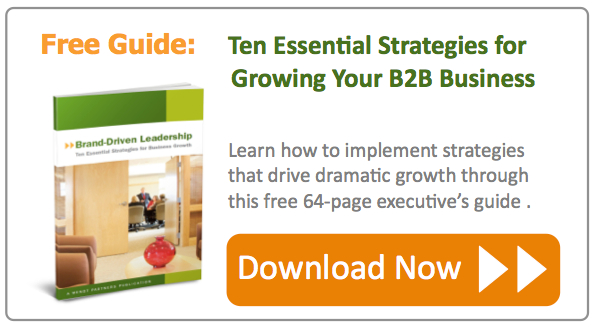Doug Wendt is a co-founder and senior partner with Wendt Partners.
 Business strategy is the cornerstone upon which a lasting program of growth is built. B2B business owners and CEOs looking to scale their company, whether from $1M to $10M or $5M to $50M, need to develop effective methods and processes to make that growth possible and sustainable. A dynamic and comprehensive business strategy is the essential roadmap that can help you build the business to scale, and achieve success. For the B2B CEO, achieving scalability begins with an honest assessment of the current structure and design of your business – and identifying what key components are necessary to strengthen and position the firm for lasting growth in the marketplace. This process requires a keen strategic focus, commitment to looking at all areas of the enterprise, and outside perspective. The StrategyFirst Action Assessment is an efficient but carefully structured evaluation that can be performed in as little as 30 days, and it is focused specifically on preparing to drive new revenue growth in your business. Every assessment process is unique, just as every business is unique. However, at its core the StrategyFirst methodology works because it is rooted in a series of key factors that can guide future efforts to grow business impact. The following are five key components essential to your strategy for scaling the business, each of which helps set the foundation for new growth:
Business strategy is the cornerstone upon which a lasting program of growth is built. B2B business owners and CEOs looking to scale their company, whether from $1M to $10M or $5M to $50M, need to develop effective methods and processes to make that growth possible and sustainable. A dynamic and comprehensive business strategy is the essential roadmap that can help you build the business to scale, and achieve success. For the B2B CEO, achieving scalability begins with an honest assessment of the current structure and design of your business – and identifying what key components are necessary to strengthen and position the firm for lasting growth in the marketplace. This process requires a keen strategic focus, commitment to looking at all areas of the enterprise, and outside perspective. The StrategyFirst Action Assessment is an efficient but carefully structured evaluation that can be performed in as little as 30 days, and it is focused specifically on preparing to drive new revenue growth in your business. Every assessment process is unique, just as every business is unique. However, at its core the StrategyFirst methodology works because it is rooted in a series of key factors that can guide future efforts to grow business impact. The following are five key components essential to your strategy for scaling the business, each of which helps set the foundation for new growth: 1. Business Planning
The business planning process has developed a poor reputation in many quarters, largely for two reasons. First, many business owners and B2B CEOs don't develop a proper business plan until they need to seek private investment or bank financing. As a result, creating a business plan is not established at the outset as a cornerstone value for the enterprise. And second, many CEOs in the B2B sector have at some point developed a business or strategic plan for the company, only to put it on the proverbial bookshelf and never implement it. Of course, this may or may not have anything to do with the quality of the plan itself – but it clearly highlights the importance of execution as a key element in the ultimate value of a business strategy.
Therefore, the Wendt Partners business planning assessment begins by examining the business plan in light of your ability to execute. If the plan calls for the company to release two new products per year, is that happening? If not, what lack of investment, infrastructure, focus or leadership has led to it not coming to fruition? The same is true across other areas of the company, especially in building the executive team and empowering executives to achieve semi-autonomous growth potential. No company can scale to 5-10 times its current size with a CEO who feels compelled to stay involved in every detail – nor can it scale if that same CEO decides she or he is simply not interested in the details, either. In assessing the business plan, we need to look at the relationship between goals, objectives, metrics, investments, actions and the leadership style of the company's executive team today.
2. Strategic Facilitation & Alignment
Carrying forward the importance of executive team culture for the success of the business strategy, it is essential to examine the capacity of the company's leaders for strategic facilitation of forward progress within the business and across the marketplace. Are they aligned around a common vision? Are business units and P&Ls structured to encourage cross-collaboration rather than unnecessary competition? How do individual departments deliver results to the business as a whole? Is the annual budgeting and capital expenditure (CapEx) planning process organized to facilitate execution of the business plan, or still operating on the basis of legacy assumptions and executives' personal preferences or outdated decision models? What decision tools (ERP, CRM, dashboards, analytics) are available to manage and report on progress, and how do they tie to the strategic goals of the firm?3. Operational Assessment
Once the business plan and organizational alignment are reviewed, the next step is to perform an operational assessment. How robust is the product or service delivery model? What infrastructure is in place to support growth – from processes and workflows to people to facilities and equipment? What vendor relationships and contracts are necessary to the core of the business? How can margins be protected or enhanced through efficiency improvements on the production side of the firm? As the market shifts and evolves, what product or service lines will become commoditized and what capabilities will be necessary in order to offer new or enhanced solutions that maintain their value? How can operational execution be codified and strengthened to support growth?4. Market Opportunity Analysis
It is also essential to perform an honest and thorough market opportunity analysis during the assessment period. Many businesses mistakenly assume that the marketplace is nearly infinite in size and that with a few tweaks and minor adjustments, they can capture unlimited marketshare just by staying the course. The reality is much more sobering, since total available market (TAM) is directly impacted by a variety of moving targets and shifting sands. One of these is the spectre of disruptive innovations. Keep in mind that Blockbuster Video considered their TAM to be every household with a television and a VCR or DVD player…until Netflix arrived. Blackberry considered their TAM to incorporate every business-class smartphone user… until the iPhone was launched. In addition to disruptive innovations, market economics change and leave yesterday's leaders high-and-dry. Consider how much many people used to pay for the Tivo system, until it became a generic commodity. Or how much school districts spent on textbooks, until the iPad eliminated the need for expensive textbooks altogether. In addition, extremely intense competition and rapidly lowering barriers to market entry mean that your firm needs to be highly selective about what market segments to serve, and how to maintain your leading position serving them.5. Turnaround or Restructuring
Three possibilities may emerge from the StrategyFirst business strategy assessment process. The first is that your business is, on the whole, well-positioned for growth and with an effective strategy you can properly scale the company. The second is that your business may not be ready for growth and needs to revisit some fundamentals and core capabilities in order to achieve scale-ready capacity for growth. And the third is that the process uncovers systemic weaknesses in the business model or current position of the company. In the third case – whether the findings apply to the entire company or, just as likely, to a specific department, product/service line or business unit, the key is to zero in and focus aggressively on turning the enterprise or business function around, or restructuring it so that the core weaknesses or issues can be resolved. It may also be the case that key leaders need to exit, or that the firm requires a fundamental repositioning in the marketplace or possibly a merger or acquisition. Turnaround strategy and corrective action requires a strong hand and a firm commitment to change, so that internal barriers (lax oversight, poor leadership, bad business processes, undercapitalization, out-of-control product development processes, weak cash position, failing products/services, underserved markets, etc.) are overcome with conviction and urgency. Of course, even if no aspect of the company needs a turnaround or restructuring, the sense of urgency about change and growth needs to be in place in order for the firm to scale effectively.StrategyFirst™ Assessment Methods
In order to evaluate these five critical components in business strategy, we utilize a range of proven strategic assessment methods. These include direct research and dialogue with key personnel; a full business plan review; process documentation audit; internal research and assessment; market opportunity analysis and an environmental scan. Our goal is to look both inside and outside your business to create a realistic picture of what is and is not working in the enterprise today; what options and actions can lead to the best short-term improvements; and what pathways and strategies can drive long-term growth. In addition, every StrategyFirst assessment includes an opening and closing strategy meeting exclusively with the CEO, and a midpoint workshop with key executive team members, focused on the strategic questions at hand.Results You Can Expect
By taking 30 days to focus on business strategy (or 6-8 weeks to examine this in conjunction with other focus areas such as sales, marketing and leadership), you can position your company to achieve successful and sustainable growth. The StrategyFirst Action Assessment will provide you with specific benchmarks and findings; a clear roadmap for moving forward; a summary action plan you can begin using right away; and recommendations for strategic decisions or opportunities that can guide your overall growth. Results achieved by clients include the ability to more clearly define and capture new business opportunities; implementation of meaningful benchmarks for growth planning and execution; achieving new efficiencies through process improvement; increasing customer satisfaction and retention; and achieving greater unity and focus on the executive team.How You Can Begin
If you're ready to achieve greater growth results and lasting scalability for your B2B business, contact Wendt Partners and take this time to learn how to reach those objectives through the StrategyFirst Action Assessment for Strategy. Or, download the guide described below to learn about ten proven strategies at the heart of successful business growth.
 Image Credit: usacoelad @ Flickr (Creative Commons)
Image Credit: usacoelad @ Flickr (Creative Commons)






